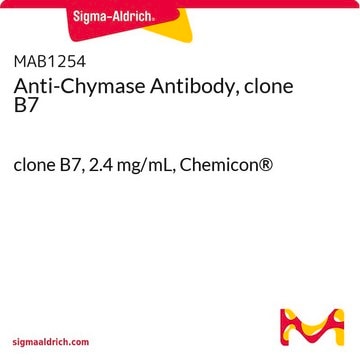MABN1185
Anti-Tau (4-repeat isoform RD4) Antibody, clone 7D12.1
clone 7D12.1, from mouse
Sinonimo/i:
Microtubule-associated protein tau, 4-repeat isoforms, Neurofibrillary tangle protein, 4-repeat isoforms, Paired helical filament-tau, 4-repeat isoforms, PHF-tau, PNS-tau, Tau-D, Tau-E, Tau-F, Tau-G
About This Item
Prodotti consigliati
Origine biologica
mouse
Livello qualitativo
Forma dell’anticorpo
purified antibody
Tipo di anticorpo
primary antibodies
Clone
7D12.1, monoclonal
Reattività contro le specie
rat, human
Reattività contro le specie (prevista in base all’omologia)
mouse (based on 100% sequence homology), bovine (based on 100% sequence homology)
tecniche
immunohistochemistry: suitable (paraffin)
western blot: suitable
Isotipo
IgG1κ
N° accesso NCBI
N° accesso UniProt
modifica post-traduzionali bersaglio
unmodified
Informazioni sul gene
human ... MAPT(4137)
mouse ... Mapt(17762) , Mapt(281296)
rat ... Mapt(29477)
Descrizione generale
Specificità
Immunogeno
Applicazioni
Neuroscience
Neurodegenerative Diseases
Qualità
Western Blotting Analysis: 0.1 µg/mL of this antibody detected Tau 4-repeat isoforms in 10 µg of rat brain tissue cytosol lysate.
Descrizione del bersaglio
Stato fisico
Stoccaggio e stabilità
Altre note
Esclusione di responsabilità
Not finding the right product?
Try our Motore di ricerca dei prodotti.
Raccomandato
Codice della classe di stoccaggio
12 - Non Combustible Liquids
Classe di pericolosità dell'acqua (WGK)
WGK 1
Punto d’infiammabilità (°F)
Not applicable
Punto d’infiammabilità (°C)
Not applicable
Certificati d'analisi (COA)
Cerca il Certificati d'analisi (COA) digitando il numero di lotto/batch corrispondente. I numeri di lotto o di batch sono stampati sull'etichetta dei prodotti dopo la parola ‘Lotto’ o ‘Batch’.
Possiedi già questo prodotto?
I documenti relativi ai prodotti acquistati recentemente sono disponibili nell’Archivio dei documenti.
Il team dei nostri ricercatori vanta grande esperienza in tutte le aree della ricerca quali Life Science, scienza dei materiali, sintesi chimica, cromatografia, discipline analitiche, ecc..
Contatta l'Assistenza Tecnica.






